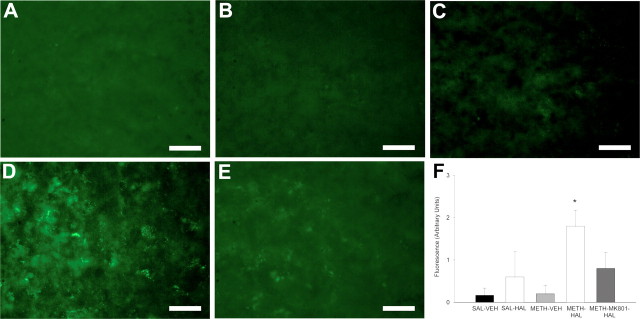Figure 8.
Subchronic HAL treatment after METH on DNA fragmentation in the SNr. Rats were administered METH (10 mg/kg 4 times, every 2 h) or 0.9% saline (1 ml/kg 4 times, every 2 h) on day 0 and then HAL (0.5 mg/kg) or vehicle (VEH) once daily on days 3–7. One group received MK-801 (0.1 mg/kg, i.p.) daily, 15 min before each HAL on days 3–7. Rats were killed on day 14. Coronal sections were processed for fluorescence histochemistry for DNA fragment end labeling. Fluorescence was quantified on an arbitrary scale (0, no fluorescence; 1, low fluorescence; 2, intermediate fluorescence; 3, high fluorescence) and is presented in arbitrary units. Data shown are mean ± SEM. Representative fluorescence photos illustrating DNA fragment end labeling in the SNr are shown from rats treated with SAL–VEH (A), SAL–HAL (B), METH–VEH (C), METH–HAL (D), and METH–MK-801–HAL (E). F, Immunofluorescence intensity showed a significant increase in DNA fragment end labeling in the METH–HAL treatment group compared with the SAL–VEH control group. Scale bars, 200 μm. Significance was determined via Kruskal–Wallis one-way ANOVA on ranks followed by Dunn's post hoc test; *p < 0.05 compared with SAL–VEH. n = 6 for SAL–VEH; n = 5 for SAL–HAL; n = 5 for METH–VEH; n = 5 for METH–HAL; n = 5 for METH–MK-801–HAL.

